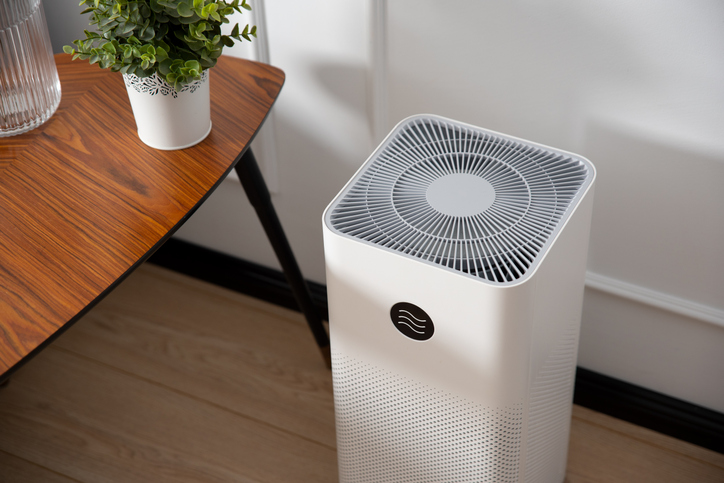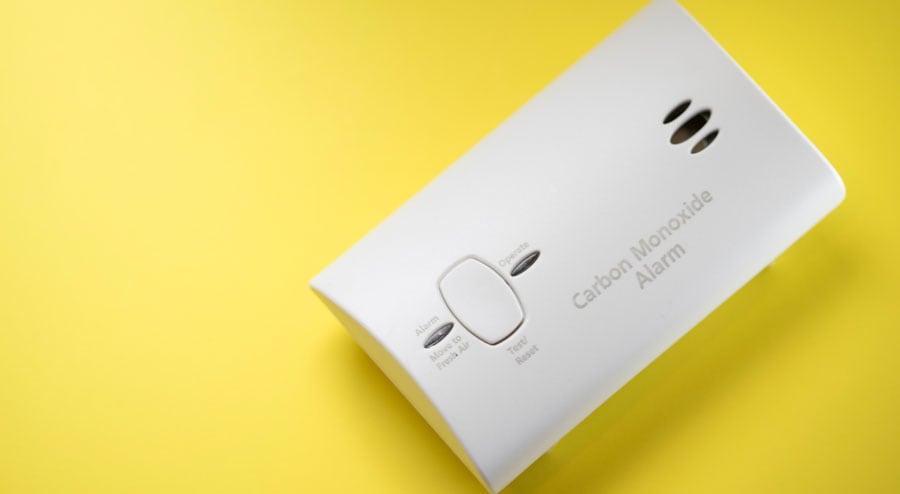The air we breathe inside our homes can be filled with pollutants and allergens that, over time, can lead to respiratory issues, allergies, and other health problems. Understanding and improving indoor air quality is important for creating a healthier living environment for ourselves, our families, and our friends.

There are various factors that contribute to indoor air pollution including common indoor pollutants like dust mites, pet dander, and mold as well as more harmful substances like carbon monoxide and radon. It is important to understand how to identify and address these issues effectively. Furthermore, there are many practical steps and strategies to enhance indoor air quality, such as proper ventilation, the use of air purifiers, and the incorporation of indoor plants to naturally purify the air.
Understanding Indoor Air Quality
Indoor air quality refers to the condition of the air within a building or enclosed space, such as our homes, schools, and workplaces. Good indoor air quality ensures that the air we breathe is clean, free from pollutants, and safe for our health as we tend to spend a significant portion of our time indoors. Therefore, understanding common pollutants and how they can affect our health is important to protecting our well-being.
Common Indoor Air Pollutants and Their Health Effects
Numerous pollutants can be present in our indoor spaces and negatively impact our health. Particulate matter, such as dust, pet dander, and pollen, can trigger allergies and respiratory issues, especially for individuals with preexisting conditions. Volatile organic compounds (VOCs) released from household products and building materials can lead to headaches, dizziness, and long-term health problems with prolonged exposure.
The Link Between Indoor Air Quality and Respiratory Conditions, Allergies, and Overall Well-being
Research has shown a clear correlation between poor indoor air quality and an increased prevalence of respiratory conditions like asthma and allergies. Additionally, long-term exposure to indoor air pollutants can contribute to chronic health problems, including cardiovascular issues and even cancer. Improving indoor air quality is essential for safeguarding our health and ensuring a comfortable living environment.
Potential Sources of Indoor Air Pollution in Homes
Indoor air pollution can originate from various natural and human-made sources including inadequate ventilation, tobacco smoke, cleaning products, and improperly maintained heating and cooling systems. Additionally, mold growth in damp or poorly ventilated areas can release spores that contaminate the air we breathe. Identifying and addressing these sources is crucial to enhancing indoor air quality and maintaining a healthier living environment for ourselves and our families.
Identifying Indoor Air Pollutants
Having the tools to be able to identify indoor air pollutants is an important aspect of maximizing your air quality. Being able to test and prevent the buildup of harmful chemicals is very important in maintaining a healthy living space.
How to Identify and Test for Indoor Air Pollutants in Your Home
Some pollutants are visible or produce noticeable odors, such as tobacco smoke or mold growth. While these pollutants are identifiable, many harmful substances are invisible to the naked eye, making testing essential.
Consider investing in an indoor air quality monitor. These devices measure various pollutants like particulate matter, VOCs, carbon dioxide, and humidity levels, providing real-time data on the air quality in your home. Additionally, there are DIY air testing kits available that can detect specific pollutants like radon or mold. Alternatively, you can hire a professional indoor air quality testing service to conduct comprehensive assessments and provide expert recommendations based on their findings.
The Dangers of Carbon Monoxide and Methods to Prevent Its Accumulation Indoors
Carbon monoxide (CO) is a deadly, odorless, and colorless gas produced by the incomplete combustion of fossil fuels like natural gas, oil, and wood. It poses a severe health risk as it binds to hemoglobin in the blood, reducing the body’s ability to transport oxygen. High levels of CO exposure can lead to symptoms like headaches, dizziness, nausea, and, in extreme cases, death.
Be sure to have carbon monoxide detectors installed on every level of your home to prevent carbon monoxide buildup indoors, especially near bedrooms. These detectors will sound an alarm if CO levels become dangerous, giving you time to evacuate and seek fresh air. Additionally, regular maintenance of fuel-burning appliances, such as furnaces, water heaters, and fireplaces, is essential to ensure they are functioning properly and not producing excess CO.
Understanding Radon and Steps for Testing and Mitigation
Radon is a naturally occurring radioactive gas that can seep into homes from the ground. It is colorless and odorless, making it undetectable without proper testing. Prolonged exposure to high levels of radon increases the risk of lung cancer, especially for smokers or individuals with preexisting respiratory conditions.
Testing for radon is relatively simple and can be done using radon testing kits, available at home improvement stores or through certified radon professionals. Short-term tests are usually conducted for a few days, while long-term tests can take several months to provide a more accurate average radon level. If elevated radon levels are detected, radon mitigation systems can be installed to vent the gas safely outdoors, preventing its accumulation in the home. These systems typically cost between $800 to $1,500, depending on the complexity of the installation and the size of the property.
Common Indoor Air Pollutants
In identifying common air pollutants and allergens that may be found in our homes including dust mites, pet dander, pollen, mold, and even air fresheners, it is important to know how to eliminate and address these issues before they pose a risk to your health.
Reducing Allergens – Dust Mites, Pet Dander, and Pollen
Allergens like dust mites, pet dander, and pollen can trigger allergic reactions and respiratory issues, particularly in individuals with allergies or asthma. To reduce these allergens in your home, start by regularly cleaning and vacuuming carpets, rugs, and upholstery using a vacuum cleaner equipped with a HEPA filter. HEPA filters can capture tiny particles like dust mites and pollen, preventing them from being recirculated into the air.
Frequent washing of bedding, curtains, and pet bedding in hot water can also help control dust mites and pet dander. Consider using allergen-proof mattress and pillow covers to further protect against dust mites. If pollen is a concern, keep windows and doors closed during peak pollen seasons, and use air conditioning with a high-efficiency filter to filter out airborne pollen particles. Additionally, grooming pets regularly and keeping them out of bedrooms can minimize pet dander in the home.
Mold and Its Impact on Indoor Air Quality: Prevention and Control Measures
Mold is a common indoor air pollutant that thrives in damp and poorly ventilated areas. It releases spores that can become airborne and cause respiratory issues, allergies, and even more severe health problems. Preventing and controlling mold growth is crucial for maintaining good indoor air quality.
Ensure proper ventilation in areas like bathrooms, kitchens, and basements to prevent mold. Use exhaust fans or open windows to reduce humidity levels and prevent moisture buildup. Fix any leaks or water damage promptly, and consider using a dehumidifier in humid areas to keep humidity levels in check.
If you discover mold in your home, address it immediately. Small areas of mold can often be cleaned with a mixture of water and detergent. For larger or more severe mold infestations, consider hiring a professional mold remediation service to safely and effectively remove the mold and prevent further growth.
Household Cleaning Products and Air Fresheners
Household cleaning products and air fresheners can help maintain a clean and fresh-smelling home but also contribute to indoor air pollution by releasing harmful chemicals into the air. Volatile organic compounds (VOCs) are common in many cleaning products and air fresheners and can lead to respiratory irritation and other health issues with prolonged exposure.
To minimize the impact of these products on indoor air quality, consider opting for eco-friendly and low-VOC cleaning products. Look for products labeled as “green” or “environmentally friendly” as they typically have fewer harmful chemicals. Alternatively, consider making your own cleaning solutions using simple ingredients like vinegar, baking soda, and lemon juice. When using air fresheners, choose natural alternatives like essential oil diffusers or air purifiers with built-in aromatherapy features. These options provide pleasant scents without releasing harmful chemicals into the air.
Improving Indoor Air Quality
There are various methods that can be utilized to improve your indoor air quality including ventilation techniques, HEPA filters, air purifiers, natural plants, and other methods such as essential oils or charcoal. Understanding how these methods work to eliminate pollutants can allow you to implement them in your home in an effective way.
Effective Ventilation Techniques and the Importance of Proper Air Circulation
Proper ventilation is a key factor in improving indoor air quality as good ventilation ensures a continuous flow of fresh air into your living spaces while expelling stale, polluted air. To achieve effective ventilation, open windows, and doors whenever possible to allow cross-ventilation. Use exhaust fans in bathrooms and kitchens to remove excess moisture and airborne pollutants.
Furthermore, consider installing a whole-house ventilation system that integrates with your heating and cooling system. These systems provide a controlled exchange of indoor and outdoor air, filtering out pollutants and maintaining optimal humidity levels. Regularly cleaning and maintaining your HVAC system’s air filters is also essential to ensure efficient air circulation and filtration.
The Benefits of Using HEPA Filters in Vacuum Cleaners and Air Purifiers
HEPA (High-Efficiency Particulate Air) filters are highly effective at capturing microscopic particles like dust, pollen, pet dander, and even some bacteria and viruses. Using a vacuum cleaner equipped with a HEPA filter can significantly reduce the amount of airborne particles in your home when cleaning. This is especially beneficial for individuals with allergies or asthma, as it helps minimize exposure to allergens.
Air purifiers with HEPA filters are also valuable tools in improving indoor air quality as they can efficiently remove airborne particles and pollutants, providing cleaner and fresher air. When choosing an air purifier, consider factors such as the size of the room, the CADR (Clean Air Delivery Rate) of the unit, and the filter replacement costs. Popular air purifier brands with HEPA filters include Dyson, Honeywell, and Levoit, with prices ranging from $100 to $400 depending on the model and features.
Air Purifiers in Combating Indoor Air Pollutants
Assess your specific needs and the size of the area you want to purify when selecting an air purifier. Look for a purifier with multiple filtration stages, including a pre-filter, HEPA filter, and activated carbon filter. The pre-filter captures large particles, extending the lifespan of the HEPA filter, while the activated carbon filter effectively absorbs odors and VOCs.
Air purifiers with additional features like UV-C light and ionizers can further improve air purification by killing bacteria and neutralizing certain pollutants. However, it’s important to note that some individuals may be sensitive to ozone produced by ionizers, so caution is advised.
How Indoor Plants Can Naturally Improve Air Quality and Create a Healthier Living Space
Indoor plants can play a significant role in improving air quality as they absorb carbon dioxide and release oxygen through photosynthesis, effectively cleaning the air. Certain plants, like spider plants, peace lilies, and aloe vera, can also help remove indoor air pollutants such as formaldehyde, benzene, and trichloroethylene.
To maximize the air-purifying benefits, place several indoor plants throughout your home, especially in rooms with a higher concentration of pollutants, such as the kitchen and living room. Be mindful of proper plant care, as unhealthy plants may attract pests or even release mold spores. Water and fertilize them appropriately and ensure they receive adequate sunlight for optimal growth and air-purifying capabilities.
Natural Methods for Improving Indoor Air Quality
In addition to traditional air purifiers, natural methods such as essential oils and charcoal can help improve indoor air quality. Essential oils, known for their pleasant aromas, also possess antimicrobial properties that can help eliminate airborne bacteria and viruses. Using an essential oil diffuser can freshen the air while potentially reducing microbial contaminants.
Activated charcoal is another natural air purifier and works by adsorbing toxins and odors, effectively trapping them within its porous surface. Placing bowls of activated charcoal in areas prone to odors, such as the kitchen or near litter boxes, can help neutralize unpleasant smells and improve indoor air quality. Regularly replacing the activated charcoal every few months will maintain its effectiveness.
Implementing a combination of traditional air purifiers and natural methods can create a synergistic effect, resulting in a healthier and more pleasant living environment.
Indoor Humidity and Ventilation
Humidity is a factor that should be greatly considered when discovering indoor air quality as it can lead to the accumulation of harmful substances. Ventilation is key when monitoring and adjusting humidity levels and maintaining a safe home environment.
The Impact of Humidity on Indoor Air Quality and Maintaining Ideal Humidity Levels
Indoor humidity levels play an important role in maintaining good air quality and a comfortable living environment. High humidity can create a breeding ground for mold, dust mites, and other allergens, while low humidity can lead to dryness and discomfort. The ideal indoor humidity level is generally recommended to be between 30% to 50%.
To monitor and maintain indoor humidity levels, use a hygrometer, a device that measures humidity in the air. If humidity is too high, especially during humid weather or in areas with poor ventilation, consider using a dehumidifier to remove excess moisture from the air. Dehumidifiers are available in various sizes and capacities to suit different room sizes and can cost anywhere from $150 to $300.
Properly Ventilating Areas with High Moisture, Such as Bathrooms and Kitchens
You can reduce humidity levels and prevent the growth of mold and mildew by properly ventilating areas prone to high moisture such as bathrooms and kitchens. Be sure that bathrooms have exhaust fans that vent outside to expel moist air generated during showers and baths. If your bathroom lacks an exhaust fan, consider opening a window while bathing to allow moisture to escape.
In the kitchen, use the range hood or exhaust fan when cooking to remove excess humidity and cooking odors. If you don’t have a range hood, opening a window can also help improve ventilation. Additionally, consider using a kitchen air purifier with a HEPA filter and activated carbon to trap cooking-related particles and odors.
Properly managing indoor humidity levels and ensuring adequate ventilation in areas with high moisture significantly contributes to better indoor air quality and creates a healthier living environment for you and your family.
Building Materials and Furnishings
Building materials and certain furnishings possess the risk of potentially releasing harmful chemicals into our environment. It is hence important to purchase low-VOC products when modifying your home in order to maximize your indoor air quality.
The Potential Release of Harmful Chemicals from Building Materials and Furnishings
The building materials and furnishings in our homes can release harmful chemicals known as volatile organic compounds (VOCs) into the air, contributing to indoor air pollution. VOCs are emitted as gases from various products, such as paints, adhesives, carpets, and furniture. Long-term exposure to high levels of VOCs can lead to respiratory irritation, headaches, and even more severe health issues.
When renovating or furnishing your home, be mindful of the potential for VOC emissions. Look for products that are labeled as low-VOC or zero-VOC, indicating that they contain fewer or no harmful chemicals. Many reputable paint brands offer low-VOC or VOC-free paint options. For instance, Sherwin-Williams offers a line of GreenSure® paints, and Benjamin Moore has its Natura® line, both of which are low-VOC and environmentally friendly. When selecting carpets and furniture, consider materials made from natural fibers like wool or organic cotton, as they tend to emit fewer VOCs.
Tips for Selecting Low-VOC Products to Promote Better Indoor Air Quality
To promote better indoor air quality, prioritize low-VOC products when decorating or furnishing your home. Look for certification labels such as GREENGUARD or GREENGUARD Gold, which indicate that a product has been tested and certified for low chemical emissions. These certifications ensure that the products meet rigorous indoor air quality standards and contribute to a healthier living environment.
When choosing building materials, opt for water-based paints and adhesives instead of solvent-based ones, as they tend to have lower VOC content. Similarly, select formaldehyde-free or low-formaldehyde products for furniture and cabinetry. Additionally, consider using natural alternatives for finishes and sealants, like beeswax or linseed oil, which emit fewer harmful chemicals.
Be proactive and select low-VOC products in order to significantly reduce indoor air pollution and create a safer and healthier living space for yourself and your family. Low-VOC products may sometimes have a slightly higher upfront cost but the long-term benefits to your health and well-being are worth the investment.
Maintaining a Smoke-Free Environment
One of the most significant threats to indoor air quality is secondhand smoke, which contains more than 7,000 chemicals, many of which are known to be toxic and carcinogenic. Secondhand smoke exposure can lead to various health issues, particularly in children, the elderly, and individuals with respiratory conditions.
If you or someone in your household smokes, the best way to improve indoor air quality is to create a smoke-free home. Smoking outdoors is the most effective way to prevent secondhand smoke from entering your living spaces. Designate a smoking area away from doors and windows to ensure that smoke does not reenter the house.
For smokers who wish to quit, various resources are available, such as quitlines, online support groups, and smoking cessation programs offered by health organizations. Quitting smoking not only benefits your own health but also significantly improves indoor air quality for everyone in your home.
Thorough cleaning and airing out the spaces can help remove residual smoke particles in homes that have been previously exposed to tobacco smoke. Wash all surfaces, including walls and ceilings, with a mixture of vinegar and water to neutralize odors. Use an air purifier with a HEPA filter and activated carbon to further reduce smoke particles and lingering odors.
Eliminating smoking indoors and taking steps to remove residual smoke ensures a smoke-free environment and significantly improves indoor air quality subsequently creating a healthier living space for all.
Special Considerations
Apart from the identifiable pollutants and observable effects on our homes and health, there are other factors to consider when it comes to the effects of indoor air quality on our well-being. Such considerations include effects on our sleep, the effect on individuals with respiratory conditions and more.
Indoor Air Quality and Sleep Quality
The quality of the air we breathe indoors can significantly impact our sleep patterns and overall sleep quality. Poor indoor air quality can lead to discomfort, irritations, and allergies that disrupt sleep, leaving us feeling fatigued and unrefreshed in the morning. On the other hand, clean and fresh indoor air promotes better sleep and overall well-being.
Keep the bedroom well-ventilated and free from potential allergens to improve sleep quality through better indoor air quality. Consider using an air purifier with a HEPA filter in the bedroom to remove airborne particles that could disturb sleep. Additionally, investing in a high-quality mattress and hypoallergenic bedding can help reduce allergens like dust mites, ensuring a restful night’s sleep.
Indoor Air Quality Guidelines and Certifications Set by Governments and Health Organizations
Governments and health organizations worldwide have established guidelines and certifications to address indoor air quality concerns. For instance, the United States Environmental Protection Agency (EPA) provides resources and guidelines on indoor air quality, including tips on improving indoor air and information on specific pollutants. Similarly, the World Health Organization (WHO) offers comprehensive guidelines and recommendations for maintaining healthy indoor air quality.
Certifications like the GREENGUARD and GREENGUARD Gold, mentioned earlier, indicate that a product meets specific indoor air quality standards and contributes to a healthier living environment. These certifications are valuable tools for consumers seeking low-VOC products and materials.
Tailoring Indoor Air Quality Improvements for Individuals with Respiratory Conditions like Asthma and Allergies
For individuals with respiratory conditions like asthma and allergies, indoor air quality becomes even more critical as pollutants and allergens in the air can trigger asthma attacks and exacerbate allergy symptoms. Therefore, indoor air quality improvements should be customized to cater to their specific needs.
For individuals with asthma or allergies, consider using air purifiers specifically designed to capture allergens like pet dander, pollen, and dust mites. Brands like Blueair and AllerAir offer air purifiers with advanced filtration systems that target allergens effectively. Moreover, maintaining a smoke-free environment, as discussed earlier, is crucial for those with respiratory conditions as secondhand smoke can be particularly harmful.
Consulting with healthcare professionals or indoor air quality specialists can provide personalized advice on improving the air quality in homes with individuals who have respiratory conditions. With tailored approaches, individuals with asthma and allergies can create a safer and healthier living environment, reducing the frequency and severity of their symptoms.
Final Thoughts
Improving indoor air quality is essential for a healthier and more comfortable living environment. Identifying and addressing common indoor air pollutants like dust mites, pet dander, mold, and VOCs is crucial. Effective ventilation, air purifiers with HEPA filters, and indoor plants can enhance air quality. Selecting low-VOC building materials and furnishings is essential, especially for individuals with respiratory conditions. Creating a smoke-free environment and considering natural methods like essential oils and charcoal are beneficial. By implementing these suggestions, we can enjoy cleaner, fresher, and healthier indoor air, promoting better respiratory health and overall well-being.




